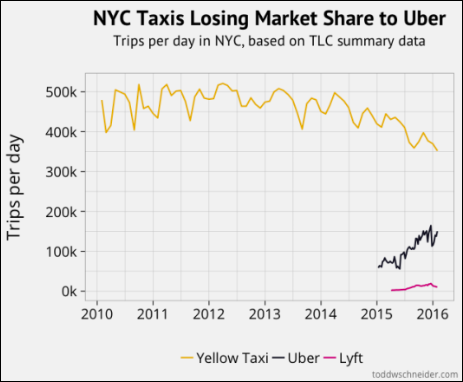By Jeffrey Tobias-
“Let’s grab an Uber”. It’s a phrase that’s so commonplace these days, but imagine 10 years ago someone telling you that you would get around by catching rides from a complete stranger in an unlicensed car.
How is it that this startup from nowhere has completely disrupted the taxi industry and is forcing the hand of regulators around the globe?
Let’s start with some facts. The graphs below depict the number of trips taken by yellow taxis and for-hire vehicles in New York City each day.
(Lyft is a competitor to Uber in the US, offering not only a ride but also a fun experience during the ride – added value, so to speak)
The graph clearly shows Uber taking market share straight from the hands of traditional yellow taxis.
Here are some staggering numbers (courtesy of DMR and Forbes) that really tell the story:
Valuation: US $62.5 billion
Funding raised: US $10.3 billion
Number of drivers: 160,000 and growing
Number of users: More than 8 million
Number of locations: Over 400 cities in over 68 countries
Number of rides: Over 1 million each day and over 1 billion in total
To put these numbers in context, Uber’s valuation is greater than either Ford or General Motors. How is a seven year old startup that is making substantial financial losses (US $1.7 billion last financial year!) valued greater than two century-old car companies that essentially built the automotive industry?
Uber’s compelling value propositions
Uber has created incredibly compelling value propositions for both its customers and drivers that have driven its exponential popularity, delivering on all three components of the Value Proposition Canvas:
- Delivering ‘jobs-to-be-done’ – They solve practical everyday problems like effortlessly finding a ride
- Relieving pains – They flip poor customer experiences on its head, like the impersonal and sometimes gruff service you receive from taxis
- Creating gains – They include delight factors that create a ‘buzz’ around the service like receiving free mints and water during your ride
Here is a laundry list of examples of Uber delivering great value propositions:
For Uber customers:
- Customers pay less to ride in an Uber than in a taxi
- Customers don’t have to hunt for taxis on the street
- Customers get free rides and promotions for being loyal users
- Customers get to use a slick app with features like fare splitting with friends and playing your own music on Spotify
- Customers can choose the quality of both their car and their driver
- Customers get fee mints and water and a nice driver that talks to them
- Customers never pull out their wallets and payment happens magically in the background
For Uber drivers:
- Drivers can make additional income at a time that suits them
- Drivers can make money from a car that usually costs them money
- Drivers get paid to be online, even if they don’t get any ride requests
- Drivers get paid with a minimum of fuss (like the seamless customer payments)
- Drivers that love to drive can earn money while pursuing their passion
To support these compelling value propositions, Uber has a scalable growth strategy that has enabled it to launch into over 400 cities in just 7 years. Like most startups, Uber is faced with the same chicken and egg problem – should they acquire the drivers before the customers or the customers before the drivers?
Fortunately Uber has some advantages to help it tackle this issue:
- Uber has lots of money to incentivise both drivers and customers
- Uber has an incredible brand that gets curious early adopters
- Uber has a rock solid roll-out strategy that has been refined over time
Everything starts with a small city launch team. Every city has a general manager who heads the customer acquisition as well as driver acquisition. The first cabs to come on board are generally professional drivers who are already associated with local taxi companies and have their own cars.
First customers come from various local advertising channels like FM radio, newspapers, online advertising etc. More importantly, Uber is so compelling that people are already waiting for the ride-sharing company to start in their city.
Not to mention Uber’s creative marketing – like delivering puppies for a cuddle, Messina Gelato, the opportunity to pitch your business idea to a venture capitalist in the back of an Uber, and its April Fools prank – delivering babies for a cuddle!
The lesson is clear – deliver an awesome customer value proposition, back it up with a slick customer experience and some fun factors, and the marketing hype will take care of itself.
Join 10,000 others who want the latest insights, tools, tips and resources. We help you get better results by staying on top of the latest methodologies and thinking














